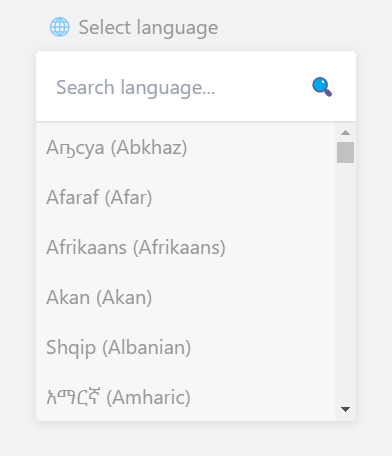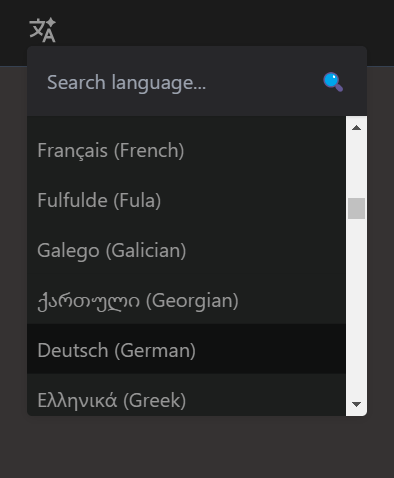
Research
/Security News
Critical Vulnerability in NestJS Devtools: Localhost RCE via Sandbox Escape
A flawed sandbox in @nestjs/devtools-integration lets attackers run code on your machine via CSRF, leading to full Remote Code Execution (RCE).
react-language-selector-lite
Advanced tools
A lightweight language selector for React applications.
react-language-selector-lite is a lightweight and customizable React component for selecting languages, featuring ISO 639 macrolanguage support, and TypeScript compatibility. It offers search functionality, themes (light and dark), and flexible configurations. This package is built using styled-components for seamless integration into any React project. 🚀
ISO 639 is a set of international standards that lists short codes for language names. The ISO 639-1 and ISO 639-2 codes are primarily used, and these codes cover the majority of languages in the world. This package uses ISO 639 macrolanguages to ensure comprehensive and accurate representation of languages.
For more information about ISO 639 macrolanguage, visit the Wikipedia page.
Install the package via npm or yarn:
npm install react-language-selector-lite
or
yarn add react-language-selector-lite
import React from 'react';
import LanguageSelector from 'react-language-selector-lite';
const App = () => {
const handleLanguageSelect = (language) => {
console.log('Selected language:', language);
// Will return the code of the selected language. e.g. 'es'
// You can also access the language details by passing `includeDetails` prop as true. e.g.
// {1: 'es', 2: 'spa', 3: 'spa', name: 'Spanish', local: 'Español', 2T: 'spa', 2B: 'spa'}
};
return (
<div>
<LanguageSelector onSelect={handleLanguageSelect} />
</div>
);
};
export default App;


You can use your own custom toggle button by passing defaultToggleBtn prop as false and rendering the select container with reference to your custom button. Here's an example: Easy peasy!
import React, { useRef } from 'react';
import { RiTranslateAi2 } from "react-icons/ri";
import LanguageSelector from 'react-language-selector-lite';
const App = () => {
const customButtonRef = useRef(null);
const handleLanguageSelect = (language) => {
console.log('Selected language:', language);
// {1: 'de', 2: 'deu', 3: 'deu', name: 'German', local: 'Deutsch', 2T: 'deu', 2B: 'ger'}
};
return (
<div className="relative w-full">
<button ref={customButtonRef}>
<RiTranslateAi2 className="size-6" />
</button>
<LanguageSelector
onSelect={(value) => handleLanguageSelect(value)}
theme="dark"
includeDetails={true}
defaultToggleBtn={false}
buttonRef={customButtonRef}
/>
</div>
);
};
export default App;

You can limit the available options by passing an array of language codes to the options prop:
<LanguageSelector
onSelect={handleLanguageSelect}
options={['en', 'es', 'fr']}
/>
Visit the NPM official package page for more information.
| Prop Name | Type | Default Value | Description |
|---|---|---|---|
onSelect | (language: any) => void | Required | Callback function triggered when a language is selected. |
includeDetails | boolean | false | Whether to include detailed language info in onSelect. |
geoCoverage | string: "local"/ "international"/ "both" | "both" | Display local names or international names of languages. |
reverseNames | boolean | false | Reverse the order of the language names when geoCoverage is set to both. |
enableSearch | boolean | true | Enable search functionality. |
options | string[] | [] | Array of language codes to limit available options. |
sortOptions | boolean | true | Whether to sort the list of languages alphabetically. |
buttonLabel | string | "Select language" | Label for the toggle button. |
placeholder | string | "Search language..." | Placeholder text for the search input. |
notFoundLabel | string | "Language not found" | Label for the not found message. When set to an empty string "" the message will not show up. |
width | string | 20rem | Adjust the width of the selector container. |
className | string | "" | Custom CSS class for styling the selector container. |
toggleBtnClass | string | "" | Custom CSS class for styling the default toggle button. |
searchClass | string | "" | Custom CSS class for styling the search input container. |
defaultToggleBtn | boolean | true | When set to false, the default toggle button will be hidden and the user can provide their own custom toggle button. |
toggleBtnIcon | React.ReactNode / string | "🌐" | Customizes the icon displayed on the toggle button. You can use an emoji (e.g., "🌍"), a React component (e.g., <FaGlobe />), or a custom SVG. |
searchIcon | React.ReactNode / string | "🔍" | Customizes the icon displayed inside the search input. You can use an emoji (e.g., "🔦"), a React component (e.g., <FaSearch />), or a custom SVG. |
buttonRef | React.RefObject< HTMLButtonElement> | null | A reference to a custom button that toggles the visibility of the language selector container. |
render | string: "onClick" / "onHover" | "onClick" | To render / display the language selector container onclick or onhover event of the toggle button. |
theme | "light" / "dark" | "light" | Theme of the component. |
The component uses styled-components for styling. You can add custom styling by utilizing the following props; className for the selector container, toggleBtnClass for the default toggle button and searchClass for the search container.
To use the dark theme, simply set the theme prop to "dark":
<LanguageSelector onSelect={handleLanguageSelect} theme="dark" />
You can customize the default toggle button icon and search icon by passing either strings (like emojis) or React nodes (like components from react-icons or custom SVGs).
<LanguageSelector
onSelect={handleLanguageSelect}
toggleBtnIcon="🌍"
searchIcon="🔦"
/>
import { FaGlobe, FaSearch } from "react-icons/fa";
<LanguageSelector
onSelect={handleLanguageSelect}
toggleBtnIcon={<FaGlobe />}
searchIcon={<FaSearch />}
/>
import GlobeIcon from "./your-path-to-svgs/GlobeIcon.svg";
import SearchIcon from "./your-path-to-svgs/SearchIcon.svg";
<LanguageSelector
onSelect={handleLanguageSelect}
toggleBtnIcon={<img src={GlobeIcon} alt="Globe" />}
searchIcon={<img src={SearchIcon} alt="Search" />}
/>
This project is licensed under the MIT License by Jamiu Shaibu
Contributions are welcome! Please fork the repository and submit a pull request for review.
git checkout -b feature-branch-name.git commit -m 'Add some feature'.git push origin feature-branch-name.If you encounter any issues or have suggestions, feel free to open an issue on GitHub or contact us directly.
Thank you for using react-language-selector-lite! Your support is greatly appreciated.
If you found this package useful, please consider buying me a coffee.
FAQs
A lightweight language selector for React applications.
The npm package react-language-selector-lite receives a total of 6 weekly downloads. As such, react-language-selector-lite popularity was classified as not popular.
We found that react-language-selector-lite demonstrated a healthy version release cadence and project activity because the last version was released less than a year ago. It has 1 open source maintainer collaborating on the project.
Did you know?

Socket for GitHub automatically highlights issues in each pull request and monitors the health of all your open source dependencies. Discover the contents of your packages and block harmful activity before you install or update your dependencies.

Research
/Security News
A flawed sandbox in @nestjs/devtools-integration lets attackers run code on your machine via CSRF, leading to full Remote Code Execution (RCE).

Product
Customize license detection with Socket’s new license overlays: gain control, reduce noise, and handle edge cases with precision.

Product
Socket now supports Rust and Cargo, offering package search for all users and experimental SBOM generation for enterprise projects.